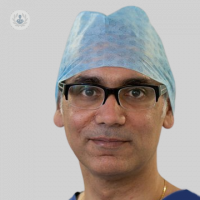What is a vasovasostomy?
A vasovasostomy is a microsurgical procedure to reverse a vasectomy. A vasectomy is a permanent method of contraception. It is a surgical procedure to prevent sperm from travelling from the man’s testicles to his penis, making it impossible for sperm to enter a woman during intercourse, thereby preventing any potential pregnancy from occurring.
This is achieved by cutting, blocking, or tying the vas deferens – the tubes that carry sperm out of the testicles where they are made. A vasovasostomy reverses this process by reconnecting or unblocking the vas deferens to once again allow sperm to pass through.

Why is a vasovasostomy done?
Vasovasostomies are performed to try to restore fertility. While the original vasectomy may have been performed because the man and his partner wanted to avoid any future pregnancies, a vasovasostomy may be an option for those men who change their minds, either because they and their partner now want a child, or because the man has since entered into a different relationship and he and his new partner want to start a family.
What does a vasovasostomy involve?
Before a vasovasostomy is performed, the surgeon first examines the vas fluid under a microscope to check that it is good quality. This is apparent if it is clear and contains completely formed, healthy sperm. If the sperm are observed to be motile, this gives the procedure a better chance of restoring fertility.
The patient is put under general anaesthetic. In some cases, the procedure may be performed with local anaesthetic such as an epidural. The urological surgeon then enters the scrotum and reconnects the severed ends of the vas deferens, taking care to ensure a good blood supply and watertight sutures. If the sutures are too large and the connection is not watertight, the vasovasostomy can fail.
How successful are vasovasostomies?
Vasovasostomies can restore fertility in some cases, but not all. The longer the time between the vasectomy and the reversal procedure, the lower the chance of success. This is because the body tends to develop anti-sperm antibodies after a vasectomy, which are thought to lower sperm motility.
Other potential obstacles to achieving pregnancy after a vasectomy and subsequent vasovasostomy include blockages in the vas deferens and factors with the female partner.
What are the main alternatives to a vasovasostomy?
Another type of vasectomy reversal procedure is a vasoepididymostomy, which is more technically demanding than a vasovasostomy and involves connecting the severed vas deferens directly to the epididymis (the tube connecting the testicle to the vas deferens, where immature sperm are stored until they develop the ability to swim and fertilise an egg).
07-05-2013 08-01-2023Vasovasostomy (vasectomy reversal)
What is a vasovasostomy?
A vasovasostomy is a microsurgical procedure to reverse a vasectomy. A vasectomy is a permanent method of contraception. It is a surgical procedure to prevent sperm from travelling from the man’s testicles to his penis, making it impossible for sperm to enter a woman during intercourse, thereby preventing any potential pregnancy from occurring.
This is achieved by cutting, blocking, or tying the vas deferens – the tubes that carry sperm out of the testicles where they are made. A vasovasostomy reverses this process by reconnecting or unblocking the vas deferens to once again allow sperm to pass through.

Why is a vasovasostomy done?
Vasovasostomies are performed to try to restore fertility. While the original vasectomy may have been performed because the man and his partner wanted to avoid any future pregnancies, a vasovasostomy may be an option for those men who change their minds, either because they and their partner now want a child, or because the man has since entered into a different relationship and he and his new partner want to start a family.
What does a vasovasostomy involve?
Before a vasovasostomy is performed, the surgeon first examines the vas fluid under a microscope to check that it is good quality. This is apparent if it is clear and contains completely formed, healthy sperm. If the sperm are observed to be motile, this gives the procedure a better chance of restoring fertility.
The patient is put under general anaesthetic. In some cases, the procedure may be performed with local anaesthetic such as an epidural. The urological surgeon then enters the scrotum and reconnects the severed ends of the vas deferens, taking care to ensure a good blood supply and watertight sutures. If the sutures are too large and the connection is not watertight, the vasovasostomy can fail.
How successful are vasovasostomies?
Vasovasostomies can restore fertility in some cases, but not all. The longer the time between the vasectomy and the reversal procedure, the lower the chance of success. This is because the body tends to develop anti-sperm antibodies after a vasectomy, which are thought to lower sperm motility.
Other potential obstacles to achieving pregnancy after a vasectomy and subsequent vasovasostomy include blockages in the vas deferens and factors with the female partner.
What are the main alternatives to a vasovasostomy?
Another type of vasectomy reversal procedure is a vasoepididymostomy, which is more technically demanding than a vasovasostomy and involves connecting the severed vas deferens directly to the epididymis (the tube connecting the testicle to the vas deferens, where immature sperm are stored until they develop the ability to swim and fertilise an egg).


Getting ‘the snip’: common questions on vasectomies answered
By Professor Francis Chinegwundoh MBE
2024-11-20
A vasectomy is an effective form of male birth control, rendering a man sterile. It is offered to men who are very certain they don’t want to father (more) children in the future. Professor Francis Chinegwundoh from London, answers some of the most frequently asked questions by men considering undergoing this procedure. See more


How is a vasectomy reversed?
By Mr Nikesh Thiruchelvam
2024-11-06
Vasovasostomy is a surgical procedure that reverses a vasectomy. Having a vasectomy is usually done as a form of contraception for men who want to prevent pregnancy occurring. It is a microsurgical procedure and takes a lot of skill. Mr Nikesh Thiruchelvam, a top urologist who runs a dedicated vasectomy reversal clinic, explains how vasectomy reversal is achieved. See more
Experts in Vasovasostomy (vasectomy reversal)
-
Mr Sarb Sandhu
UrologyExpert in:
- Bladder cancer
- Vasovasostomy (vasectomy reversal)
- Bladder problems
- Prostate cancer
- Vasectomy
- Prostate
-
Mr Rowland Rees
UrologyExpert in:
- Penile Prosthesis
- Peyronie's disease
- Male infertility
- Vasovasostomy (vasectomy reversal)
- Urethral stricture
- Urinary incontinence
-
Mr Hussain Alnajjar
UrologyExpert in:
- Erectile dysfunction
- Penile Prosthesis
- Male infertility
- Peyronie's disease
- Vasovasostomy (vasectomy reversal)
- Andrology
-
Mr Rajagopalan Sriram
UrologyExpert in:
- Stress incontinence
- Bladder cancer
- Haematuria (blood in the urine)
- Urinary tract infection
- Vasectomy
- Vasovasostomy (vasectomy reversal)
-
Mr Musaab Yassin
UrologyExpert in:
- Holmium laser (HoLEP)
- Rezūm
- Erectile dysfunction
- Vasovasostomy (vasectomy reversal)
- Sperm retrieval
- Aquablation
- See all

The Harley Street Clinic - part of HCA Healthcare
The Harley Street Clinic - part of HCA Healthcare
35 Weymouth Street, London. W1G 8BJ
No existe teléfono en el centro.
By using the telephone number provided by TOP DOCTORS, you automatically agree to let us use your phone number for statistical and commercial purposes. For further information, read our Privacy Policy
Top Doctors

London International Patient Services (LIPS)
London International Patient Services (LIPS)
5 Devonshire Place, W1G 6HL
No existe teléfono en el centro.
By using the telephone number provided by TOP DOCTORS, you automatically agree to let us use your phone number for statistical and commercial purposes. For further information, read our Privacy Policy
Top Doctors

The Meriden Hospital - part of Circle Health Group
The Meriden Hospital - part of Circle Health Group
Clifford Bridge Road, Coventry
No existe teléfono en el centro.
By using the telephone number provided by TOP DOCTORS, you automatically agree to let us use your phone number for statistical and commercial purposes. For further information, read our Privacy Policy
Top Doctors
-
The Harley Street Clinic - part of HCA Healthcare
35 Weymouth Street, London. W1G 8BJ, Central LondonExpert in:
- Cancer
- Head and neck cancer
- Cardiology
- Intensive care
- Diagnostic Imaging
- Women’s health
-
London International Patient Services (LIPS)
5 Devonshire Place, W1G 6HL, W1G Marylebone LondonExpert in:
- Orthopaedic spinal surgery
- Plastic surgery, reconstructive and aesthetics
- Hand and wrist
- Otolaryngology
- Foot and ankle
- Knee
-
The Meriden Hospital - part of Circle Health Group
Clifford Bridge Road, Coventry , CoventryExpert in:
- Cancer
- Cardiology
- Colorectal surgery
- Shoulder surgery
- Hand surgery
- General Surgery
- See all
- Most viewed diseases, medical tests, and treatments
- Undescended testicle (Cryptorchidism)
- Testicular ultrasound
- Minimal access surgery (keyhole surgery)
- NanoKnife
- Vaginal dryness
- Pelvic pain syndrome
- Kidney stones
- Medicolegal
- Women's health
- Robotic surgery







